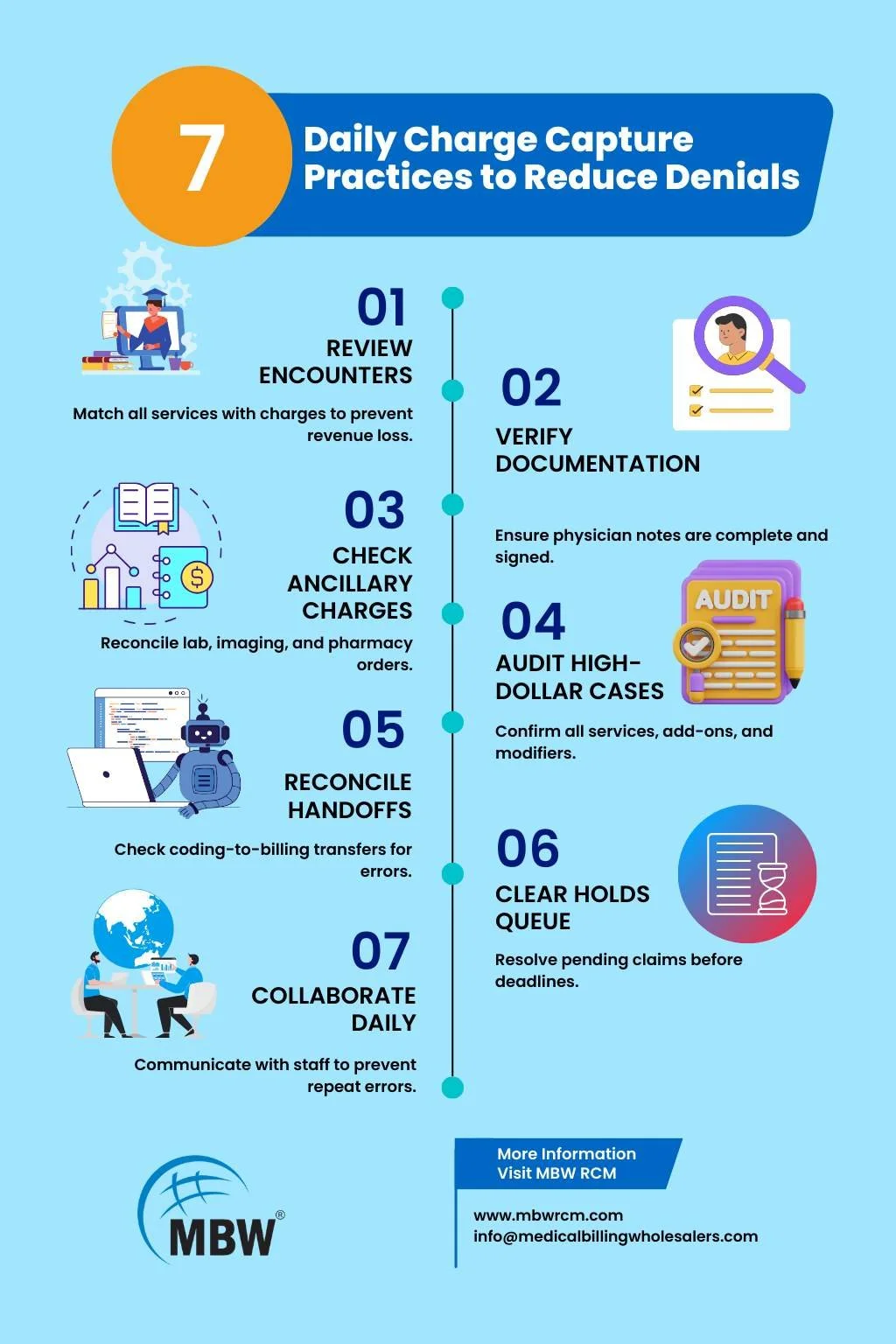The Charge Capture Checklist: 7 Things Your Team Should Be Doing Daily
What if the key to unlocking millions in lost revenue isn’t a complex AI platform or a multi-million-dollar EHR upgrade—but a simple, disciplined daily routine?
For many healthcare organizations, charge capture is treated like a game of “catch-up.” Teams rush to fix errors and denials after they occur, wasting time and resources while revenue leaks away. This reactive approach leaves money on the table and creates bottlenecks throughout the revenue cycle.
Table of Contents
The Power of Daily Habits
The solution? A proactive, daily charge capture checklist—a short but powerful series of actions that turns your workflow from reactive firefighting into a disciplined, revenue-protecting machine. By following this checklist every day, you can dramatically reduce missed charges, prevent denials, and safeguard your organization’s financial health from the ground up.
The Daily Checklist: 7 Must-Do Tasks
1. Review the Prior Day’s Encounters
Action: Pull the list of all patient encounters from the previous day. Ensure every documented service—clinical or ancillary—has a corresponding charge entered.
Why it Matters: Catching missed charges within 24 hours means they never age into DNFB (Discharged Not Fully Billed) or get forgotten entirely. HFMA research shows that missed charges can account for 1–3% of annual net revenue, often due to simple oversight.
Example: A daily review in one outpatient surgery center caught a pattern where post-op observation time wasn’t being charged—recovering $12,000 in just one month.
2. Verify Physician Documentation is Complete
Action: Confirm that all physician notes, operative reports, and discharge summaries for the previous day are signed, complete, and ready for coding.
Why it Matters: Incomplete documentation is a top reason for coding delays and claims stalling in the DNFB report. The quicker documentation is finalized, the faster claims can be coded and submitted.
Pro Tip: Use EHR alerts to notify providers of unsigned notes before the 24-hour mark.
If you are interested to read more about charge entry, please have a look at this blog on ‘‘Why Charge Entry in Medical Billing Matters More Than You Think’’.
3. Cross-Reference Ancillary Charges
Action: Compare charges from ancillary departments—such as lab, radiology, and pharmacy—against physician orders and documentation.
Why it Matters: Ancillary services are often where small leaks turn into big losses. If lab draws, imaging, or medication administrations aren’t properly captured, the revenue is gone forever.
Example: A hospital pharmacy audit discovered that IV antibiotics administered during after-hours shifts weren’t consistently entered—representing $75,000 in missed annual revenue.
4. Audit a Sample of High-Dollar Procedures
Action: Pick a few high-value or complex procedures performed the day before and run a quick mini-audit to verify that all services, add-on codes, and modifiers were captured.
Why it Matters: High-dollar services have the biggest impact on revenue per case. A 10-minute audit here can recover thousands in just one encounter.
Example: A cath lab review caught missing charges for intravascular ultrasound (IVUS) in 15% of procedures—worth over $80,000 annually.
To better understand the role this step plays in the revenue cycle, check this blog on purpose of charge entry in medical billing.
5. Reconcile Coder-to-Biller Handoffs
Action: Check that all charges released from the coding queue have moved successfully into the billing queue without getting stuck in the system.
Why it Matters: Even if coding is perfect, technical handoff errors between systems can delay claim submission and slow cash flow.
Pro Tip: Use daily “queue reconciliation reports” to ensure nothing is stranded in coding status longer than 24 hours.
6. Review and Clear the “Holds” Queue
Action: Triage any claims on hold due to missing information—such as insurance details, authorizations, or documentation gaps. Clear these daily before they approach payer timely filing deadlines.
Why it Matters: An unmanaged holds queue is a denial time bomb. Once timely filing limits are missed, that revenue is likely gone for good.
Example: A daily holds queue review at one mid-size hospital reduced timely filing denials by 40% in three months.
7. Communicate and Collaborate
Action: Proactively reach out to providers, coders, or department managers to clarify issues identified during the daily review.
Why it Matters: This builds accountability and prevents repeat errors. Solving problems at the source is faster and more cost-effective than fixing denials later. For more insights, check out these best practices to improve charge capture at the point of care.
“The best denial prevention strategy is a five-minute conversation today—not a 10-page appeal letter six months from now.”
Conclusion: From Daily Task to Financial Stability
These seven daily actions are more than a to-do list—they are a discipline. When performed consistently, they reduce missed charges, improve coding accuracy, accelerate billing, and create a culture of accountability across your organization.
By making charge capture a daily habit, you’re not just plugging revenue leaks—you’re fortifying the bridge between care delivery and payment with the support of effective charge capture services.
Want to implement a custom charge capture checklist tailored to your workflow? Contact MBW RCM today to get expert guidance, process optimization, and measurable revenue protection.


